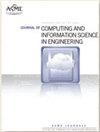“I can see your password”: A case study about cybersecurity risks in mid-air interactions of mixed reality-based smart manufacturing applications
IF 2.6
3区 工程技术
Q2 COMPUTER SCIENCE, INTERDISCIPLINARY APPLICATIONS
Journal of Computing and Information Science in Engineering
Pub Date : 2023-06-01
DOI:10.1115/1.4062658
引用次数: 0
Abstract
This paper aims to present a potential cybersecurity risk existing in Mixed Reality (MR)-based smart manufacturing applications that decipher digital passwords through a single RGB camera to capture the user's mid-air gestures. We first created a testbed, which is an MR-based smart factory management system consisting of mid-air gesture-based user interfaces (UIs) on a video see-through MR head-mounted display (HMD). To interact with UIs and input information, the user's hand movements and gestures are tracked by the MR system. We set up the experiment to be the estimation of the password input by users through mid-air hand gestures on a virtual numeric keypad. To achieve this goal, we developed a lightweight machine learning-based hand position tracking and gesture recognition method. This method takes either video streaming or recorded video clips (taken by a single RGB camera in front of the user) as input, where the videos record the users' hand movements and gestures but not the virtual UIs. With the assumption of the known size, position, and layout of the keypad, the machine learning method estimates the password through hand gesture recognition and finger position detection. The evaluation result indicates the effectiveness of the proposed method, with a high accuracy of 97.03%, 94.06%, and 83.83% for 2-digit, 4-digit, and 6-digit passwords, respectively, using real-time video streaming as input.“我能看到你的密码”:基于混合现实的智能制造应用空中交互网络安全风险案例研究
本文旨在介绍基于混合现实(MR)的智能制造应用中存在的潜在网络安全风险,该应用通过单个RGB相机破译数字密码以捕捉用户的半空中手势。我们首先创建了一个试验台,这是一个基于核磁共振的智能工厂管理系统,由基于空中手势的用户界面(ui)组成,该界面位于视频透明的核磁共振头戴式显示器(HMD)上。为了与ui和输入信息进行交互,用户的手部动作和手势由MR系统跟踪。我们将实验设置为用户通过虚拟数字键盘上的空中手势输入密码的估计。为了实现这一目标,我们开发了一种轻量级的基于机器学习的手部位置跟踪和手势识别方法。这种方法采用视频流或录制的视频片段(由用户面前的单个RGB摄像头拍摄)作为输入,其中视频记录用户的手部动作和手势,但不记录虚拟ui。假设键盘的大小、位置和布局已知,机器学习方法通过手势识别和手指位置检测来估计密码。评价结果表明了该方法的有效性,使用实时视频流作为输入,对2位、4位和6位密码的识别率分别为97.03%、94.06%和83.83%。
本文章由计算机程序翻译,如有差异,请以英文原文为准。
求助全文
约1分钟内获得全文
求助全文
来源期刊
CiteScore
6.30
自引率
12.90%
发文量
100
审稿时长
6 months
期刊介绍:
The ASME Journal of Computing and Information Science in Engineering (JCISE) publishes articles related to Algorithms, Computational Methods, Computing Infrastructure, Computer-Interpretable Representations, Human-Computer Interfaces, Information Science, and/or System Architectures that aim to improve some aspect of product and system lifecycle (e.g., design, manufacturing, operation, maintenance, disposal, recycling etc.). Applications considered in JCISE manuscripts should be relevant to the mechanical engineering discipline. Papers can be focused on fundamental research leading to new methods, or adaptation of existing methods for new applications.
Scope: Advanced Computing Infrastructure; Artificial Intelligence; Big Data and Analytics; Collaborative Design; Computer Aided Design; Computer Aided Engineering; Computer Aided Manufacturing; Computational Foundations for Additive Manufacturing; Computational Foundations for Engineering Optimization; Computational Geometry; Computational Metrology; Computational Synthesis; Conceptual Design; Cybermanufacturing; Cyber Physical Security for Factories; Cyber Physical System Design and Operation; Data-Driven Engineering Applications; Engineering Informatics; Geometric Reasoning; GPU Computing for Design and Manufacturing; Human Computer Interfaces/Interactions; Industrial Internet of Things; Knowledge Engineering; Information Management; Inverse Methods for Engineering Applications; Machine Learning for Engineering Applications; Manufacturing Planning; Manufacturing Automation; Model-based Systems Engineering; Multiphysics Modeling and Simulation; Multiscale Modeling and Simulation; Multidisciplinary Optimization; Physics-Based Simulations; Process Modeling for Engineering Applications; Qualification, Verification and Validation of Computational Models; Symbolic Computing for Engineering Applications; Tolerance Modeling; Topology and Shape Optimization; Virtual and Augmented Reality Environments; Virtual Prototyping

 求助内容:
求助内容: 应助结果提醒方式:
应助结果提醒方式:


